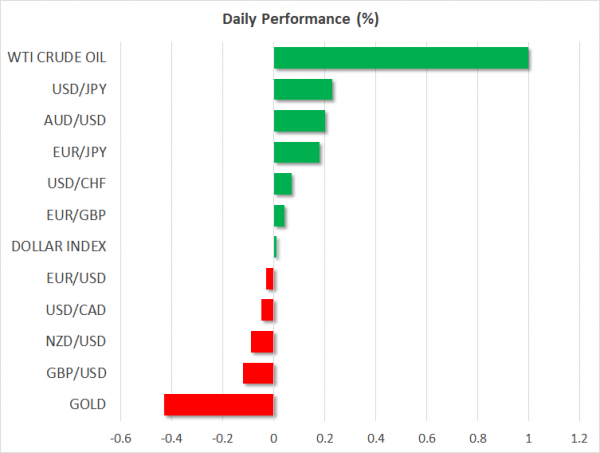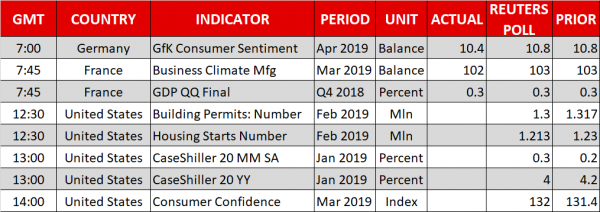- Pound holds steady as British MPs prepare to vote on alternative Brexit plans
- Dollar struggles following yield curve inversion
- Equities breathe sigh of relief as US yields edge up
Pound hovers around $1.32 as Brexit drama continues
UK Prime Minister Theresa May suffered another humiliating defeat in Parliament on Monday after lawmakers voted in favour of holding a series of indicative votes to decide the next steps in the Brexit process, seizing power away from the government. While the vote makes a no-deal Brexit less likely and the prime minister herself yesterday gave the strongest indication yet that a disorderly exit isn’t on the cards unless MPs were to choose it, the ongoing uncertainty kept sterling range-bound, with cable fluctuating around the $1.32 handle.
Parliament will on Wednesday hold a vote on seven different options, including a second referendum and staying in a customs union, as well as on revoking Article 50, which would mean cancelling Brexit. The options with the most votes will be voted on again next week until MPs preferred path becomes clearer.
May’s twice-rejected deal is also included among the alternatives for lawmakers to pick from so a third meaningful vote remains a possibility if none of the other options gather as much support. The Prime Minister cancelled a third vote on her deal this week after failing to win the backing of the Northern Irish DUP party.
US yields turn higher, but dollar flat
The US dollar was struggling for direction on Tuesday despite an easing of the slump in Treasury yields. The yield curve between 10-year and 3-month Treasury notes inverted on Friday and the negative spread deepened further on Monday, triggering fears of a US recession. The spread between 10-year and 3-month Treasuries is watched closely by the San Francisco Fed for signs of a forthcoming recession and markets also appear to be increasingly paying attention to it with investors now fully pricing in a 25-basis point rate cut by the Fed by December.
The shift in expectations comes after the Fed last week ruled out further rate hikes in 2019, reinforcing its dovish stance. The dollar fell to a 6-week low of 109.70 yen yesterday before recovering to around 110.15 yen today. But the dollar index was flat around 96.60.
The Japanese currency was facing some downside pressure of its own today after the Bank of Japan’s Summary of Opinions of the March policy meeting revealed Board members discussed the prospect of further policy easing given the growing negative risks to the world economy.
The euro meanwhile found some support from yesterday’s better-than-expected German Ifo business climate index for March and was last trading just above the $1.13 level. However, following last week’s dismal March PMI numbers, traders will need a lot more convincing that the Eurozone economy is improving before pushing the euro significantly higher.
Stocks lifted from recovering US yields
The rebound in US Treasury yields boosted global equities with most Asian indices closing in the green and US e-mini futures were also pointing to a positive start to Tuesday’s trading session. However, European stocks were mixed with a more cautious mood with recession fears still worrying many investors.
Attention later today will fall on the US consumer confidence index by the Conference Board for an indication of consumers’ spending appetite in March. US housing starts and building permits for February will also be monitored as the US economy remains under the spotlight for any signs of a deep downturn.
A speech by Chicago Fed President Charles Evans at 10:30 GMT will be watched too, while later in the day, the Reserve Bank of New Zealand will announce its latest policy decision at 20:00 GMT. The kiwi was lifted last week from solid GDP numbers out of New Zealand and was last hovering not too far from its highs around $0.69. The RBNZ is expected to keep rates at 1.75% and maintain an easing bias, but a further dovish tilt is seen unlikely following the GDP data.















